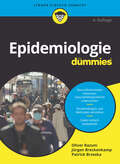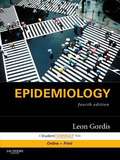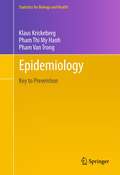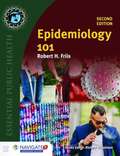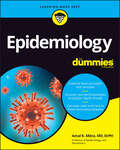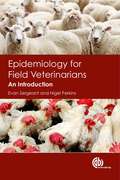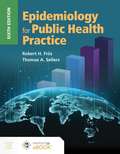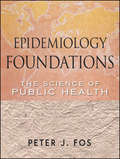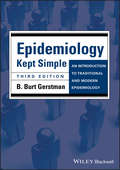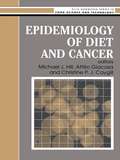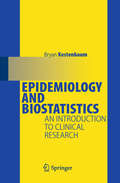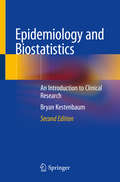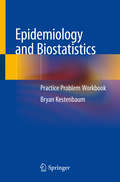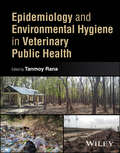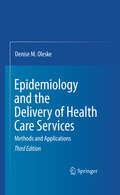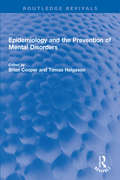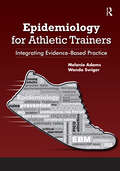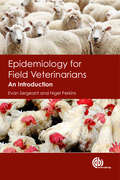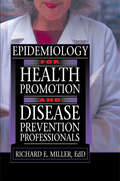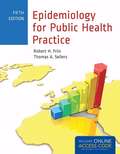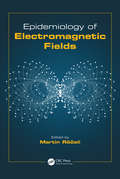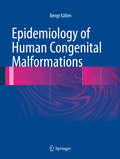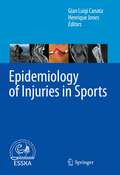- Table View
- List View
Epidemiologie für Dummies (Für Dummies)
by Oliver Razum Jürgen Breckenkamp Patrick BrzoskaWer ein gesundheitswissenschaftliches Fach oder Medizin studiert, darf sich auf die Epidemiologie freuen, denn dann wird es richtig spannend. Oliver Razum, Jürgen Breckenkamp und Patrick Brzoska führen in diesen Querschnittsbereich der Medizin und der Gesundheitswissenschaften ein. Sie erläutern, wie Epidemiologen Risikofaktoren und Krankheiten der Bevölkerung untersuchen, wie Studiendesigns aufgebaut sind und welche Methoden zur kritischen Datenanalyse angewendet werden. Anhand vieler Beispiele erfahren Sie, wie sich Seuchen wie Corona ausbreiten, warum Bewegung gesund ist und warum Rauchen krank macht.
Epidemiology
by MPH Leon Gordis DrphThis popular book is written by the award-winning teacher, Dr. Leon Gordis of the Bloomberg School of Public Health at Johns Hopkins University. He introduces the basic principles and concepts of epidemiology in clear, concise writing and his inimitable style. This book provides an understanding of the key concepts in the following 3 fully updated sections: Section I: The Epidemiologic Approach to Disease and Intervention; Section II: Using Epidemiology to Identify the Causes of Disease; Section III: Applying Epidemiology to Evaluation and Policy. Clear, practical graphs and charts, cartoons, and review questions with answers reinforce the text and aid in comprehension. Utilizes new full-color format to enhance readability and clarity. Provides new and updated figures, references and concept examples to keep you absolutely current - new information has been added on Registration of Clinical Trials, Case-Cohort Design, Case-Crossover Design, and Sources and Impact of Uncertainty (disease topics include: Obesity, Asthma, Thyroid Cancer, Helicobacter Pylori and gastric/duodenal ulcer and gastric cancer, Mammography for women in their forties) - expanded topics include Person-time. Includes STUDENT CONSULT access, allowing you to: o Access the complete contents of the book online, anywhere you goOC perform quick searchesOC and add your own notes and bookmarks. o Test yourself with the additional TEST BANK including 200 MCQs, plus complete rationales for all self-assessment Q and A in the print book. o Reference all other STUDENT CONSULT titles you own online, too-all in one place Please note: electronic rights were not granted for several images in this product. Introduces both the underlying concepts as well as the practical uses of epidemiology in public health and in clinical practice. Systemizes learning and review with study questions in each section and an answer key and index. Illustrates textual information with clear and informative full-color illustrations, many created by the author and tested in the classroom. "
Epidemiology
by Klaus Krickeberg Thi My Pham Van Trong PhamThis book is meant for adoption in first courses on epidemiology in Medical Schools and Faculties of Public Health in developing and transition countries and in workshops in these countries, taught for example by members of international organizations. It is also suitable for parallel or second reading within curricula in developed countries and for teaching epidemiology in a Master's programme on "International Health". The book will enable any lecturer to compose his or her introductory courses on epidemiology by selecting the material deemed appropriate. It will provide a solid foundation for more advanced teaching. The intended readership consists in the first place of general medical students; students following the programme "Preventive Physician" that runs parallel to general medical studies in some countries; students starting to specialize in Public Health; and lecturers in epidemiology. The book can also serve well as an introduction into epidemiology for anybody else interested in this field, for example staff of health institutions. Examples and practical work are taken from the present situation of health in Vietnam, which can easily be adapted to any other developing or transition country.
Epidemiology 101 Second Edition
by Robert H. FriisThis best-selling text will introduce you to the basics of infectious disease epidemiology, environmental epidemiology, molecular epidemiology, and psychosocial/behavioral epidemiology. Perfect for those with no prior familiarity with health-related fields or statistics, Epidemiology 101, Second Edition, uses a clear, cohesive writing style and follows the basic Epidemiology 101 curriculum framework as outlined in the AAC&U and APTR Recommendations for Undergraduate Public Health Education. End-of-chapter exercises provide access to a laboratory component for college science courses that require a laboratory.
Epidemiology For Dummies
by Amal K. MitraBecome a disease detective with this easy-to-understand resource Epidemiology For Dummies is packed with key concepts, practical applications, and real-life examples in the study of disease transmission and control. It's a must-have for students in all public-health-related fields, and for curious learners, too. This Dummies guide will help you conquer even the trickiest epidemiological concepts. In this introduction to the fascinating, complex science, you’ll learn—in terms anyone can understand—all the basic principles of epidemiology, plus how those concepts translate to public health outcomes and policy decisions. Learn the basic principles and concepts of epidemiology Discover real-world examples and public health threats Understand the complex social factors that influence health Embark on a public health career or just pass your epidemiology courseAnyone who wants or needs to understand the fundamentals of epidemiology and the science behind public health will love Epidemiology For Dummies.
Epidemiology For Field Veterinarians: An Introduction
by Evan Sergeant Nigel PerkinsIntended as an introduction for veterinarians and other animal health professionals interested in and wishing to apply epidemiological methods in their day-to-day work, this book provides a practical guide for those new to the field. Its applied focus covers the principles of epidemiology in real world situations and practical implementation of disease outbreak investigation, for both emerging and endemic diseases. Techniques and methods are discussed, supported by case studies and practical examples to illustrate their application. The book is clearly written and accessible, providing readers with practical information and encouraging the development of problem-solving skills. It is an essential handbook for veterinary surgeons and students and those involved in animal health, food safety and epidemiology.
Epidemiology For Public Health Practice
by Robert H. Friis Thomas SellersEpidemiology for Public Health Practice is a best-selling text offering comprehensive coverage of all the major topics in introductory epidemiology and alignment to the core competencies in epidemiology for graduate and undergraduate courses. With extensive treatment of the heart of epidemiology―from study designs to descriptive epidemiology to quantitative measures―this reader-friendly text is accessible and interesting to a wide range of beginning students in all health-related disciplines. A unique focus is given to real-world applications of epidemiology and the development of skills that students can apply in subsequent course work and in the field.
Epidemiology Foundations
by Peter J. FosWritten by Peter J. Fos-an expert in epidemiology with more than twenty years teaching experience-Epidemiology Foundations offers an ideal introduction to the theory and practice of public health epidemiology. This important text discusses both the historical perspective and future trends of epidemiology, reviews health and disease, and explains how they are measured. The book's overview of epidemiological studies shows how they are used in practice. Epidemiology Foundations takes a social and community perspective and includes information about global diseases and epidemics. Emphasis on concepts such as population health, social determinants, and global health make this book especially interesting and accessible to those new to the subject. Each chapter is supplemented with problem-solving exercises and research assignments to aid readers in understanding its epidemiology principles. Reflecting and expanding on recommendations of the Association of American Colleges and Universities, Epidemiology Foundations is the ideal text for any course introducing epidemiology in public health.
Epidemiology Kept Simple
by B. Burt GerstmanEpidemiology Kept Simple introduces the epidemiological principles and methods that are increasingly important in the practice of medicine and public health. With minimum use of technical language it fully explains terminology, concepts, and techniques associated with traditional and modern epidemiology. Topics include disease causality, epidemiologic measures, descriptive epidemiology, study design, clinical and primary prevention trials, observational cohort studies, case-control studies, and the consideration of random and systematic error in studies of causal factors. Chapters on the infectious disease process, outbreak investigation, and screening for disease are also included. The latter chapters introduce more advanced biostatistical and epidemiologic techniques, such as survival analysis, Mantel-Haenszel techniques, and tests for interaction.This third edition addresses all the requirements of the American Schools of Public Health (ASPH) Epidemiological Competencies, and provides enhanced clarity andreadability on this difficult subject. Updated with new practical exercises, case studies and real world examples, this title helps you develop the necessary tools to interpret epidemiological data and prepare for board exams, and now also includes review questions at the end of each chapter.Epidemiology Kept Simple continues to provide an introductory guide to the use of epidemiological methods for graduate and undergraduate students studying public health, health education and nursing, and for all practicing health professionals seeking professional development.
Epidemiology Kept Simple: An Introduction to Traditional and Modern Epidemiology
by B. Burt GerstmanEpidemiology Kept Simple introduces the epidemiological principles and methods that are increasingly important in the practice of medicine and public health. With minimum use of technical language it fully explains terminology, concepts, and techniques associated with traditional and modern epidemiology. Topics include disease causality, epidemiologic measures, descriptive epidemiology, study design, clinical and primary prevention trials, observational cohort studies, case-control studies, and the consideration of random and systematic error in studies of causal factors. Chapters on the infectious disease process, outbreak investigation, and screening for disease are also included. The latter chapters introduce more advanced biostatistical and epidemiologic techniques, such as survival analysis, Mantel-Haenszel techniques, and tests for interaction. This third edition addresses all the requirements of the American Schools of Public Health (ASPH) Epidemiological Competencies, and provides enhanced clarity and readability on this difficult subject. Updated with new practical exercises, case studies and real world examples, this title helps you develop the necessary tools to interpret epidemiological data and prepare for board exams, and now also includes review questions at the end of each chapter. Epidemiology Kept Simple continues to provide an introductory guide to the use of epidemiological methods for graduate and undergraduate students studying public health, health education and nursing, and for all practicing health professionals seeking professional development.
Epidemiology Of Diet And Cancer (Ellis Horwood Series In Food Science And Technology Ser.)
by M.J. Hill A. Giacosa Christine P.J. CaygillThis volume investigates the links between the incidence of diet-related cancers and dietary patterns within Europe. It presents current understanding of the major cancers thought to be caused by diet alongside detailed data on regional variations in dietary composition, and collates these sets of information to illustrate associations between food
Epidemiology and Biostatistics
by Bryan KestenbaumConcise, fast-paced, intensive introduction to clinical research design for students and clinical research professionals Readers will gain sufficient knowledge to pass the United States Medical Licensing Examination part I section in Epidemiology
Epidemiology and Biostatistics: An Introduction to Clinical Research
by Bryan KestenbaumThis is a concise introduction to epidemiology and biostatistics written specifically for medical students and first-time learners of clinical research methods. It presents the core concepts of epidemiology and of biostatistics and illustrates them with extensive examples from the clinical literature. It is the only book on the market written to speak directly to medical students and first-time biomedical researchers by using language and examples that are easy to understand. This newly updated second edition is extensively rewritten to provide the clearest explanations and examples. There is also a sister-text, a 150-problem workbook of practice problems that can be purchased alongside this textbook. The author continues to provide a text that is attractively fast-paced and concise for use in condensed courses, such as those taught in medical school. The book is an excellent review for the epidemiology section of the United States Medical Licensing Examination Part I which all medical students must take at the end of the second year.
Epidemiology and Biostatistics: Practice Problem Workbook
by Bryan KestenbaumThis workbook is designed to teach the major fundamental concepts in Epidemiology, Biostatistics, and clinical research design alongside the textbook "Epidemiology and Biostatistics, 2nd Edition". It is written in concise and organized fashion with many examples to illustrate the concepts deriving from a collection of written materials created to teach Epidemiology and Biostatistics to medical students. The major differences from related titles include a “story” based approach toward teaching the material, relative brevity while maintaining focus on key concepts, and taking the perspective of first-time learners (avoiding and/or clearly defining jargon, using clear common-sense language). It features a variety of questions: long, short, and multiple choice questions. The workbook is made to provide students with the tools necessary to form their own informed conclusions from the clinical research literature.
Epidemiology and Environmental Hygiene in Veterinary Public Health
by Tanmoy RanaUnderstanding the emergence and progress of zoonotic diseases Veterinary epidemiology is the study of the connection between animal exposure to chemical or disease agents and the observation of adverse effects. Veterinary epidemiologists observe the patterns by which diseases emerge in a population and play a crucial role in controlling emerging disease outbreaks and preventing infections. The major factors in environmental hygiene which have a tendency to produce disease and adverse health effects in animals require extensive study and play a potentially massive role in public health. Epidemiology and Environmental Hygiene in Veterinary Public Health provides a one-stop reference for professionals in this vital field. Its exploration of environmental illnesses and pollutants in combination with biological disease vectors has no current rivals in the marketplace. With readable design and coverage of all major factors of epidemiological significance, the volume offers a unique contribution to the control of animal disease. Epidemiology and Environmental Hygiene in Veterinary Public Health readers will also find: Schematic overview of the fundamentals of environmental hygiene and epidemiologyDetailed discussion of topics including etiological factors, preventative and control strategies, major disease agents, and many moreColor figures, line figures, and tables to illustrate key concepts Epidemiology and Environmental Hygiene in Veterinary Public Health is ideal for all professionals and researchers in animal epidemiology and environmental hygiene, as well as for farm managers, agricultural veterinarians, and other professionals involved in large-scale animal care.
Epidemiology and the Delivery of Health Care Services
by Denise M. OleskeThis completely revised and updated edition of an outstanding text addresses the fundamental knowledge of epidemiological methods and statistics that can be applied to evolving systems, programs, technologies, and policies. This edition presents new chapters on causal thinking, ethics, and web resources, analyzes data on multinational increases in poverty and longevity, details the control of transmissible diseases, and explains quality management, and the evaluation of healthcare system performance.
Epidemiology and the Prevention of Mental Disorders (Routledge Revivals)
by Brian Cooper To 769 Mas HelgasonFirst published in 1989, Epidemiology and the Prevention of Mental Disorders examines the research undertaken into the methods for studying the occurrence of mental illness in populations during the twenty years prior to publication. The book explores the incidence and distribution of conditions such as schizophrenia, depression, alcoholism, addiction, and dementia across populations, and the risk factors with which they are associated. Taking a public health approach to the prevention of mental illness, the book reports on epidemiological research in psychiatry, emphasising its use in preventative terms, and making connections between its use in psychiatry and its use in other fields of medicine. It also comments on the development of psychiatric epidemiology as a public health discipline and draws attention to the implications of contemporary changes to biological and social environments on mental health. Epidemiology and the Prevention of Mental Disorders will appeal to those with an interest in the history of psychiatric epidemiology and mental health.
Epidemiology for Athletic Trainers: Integrating Evidence-Based Practice
by Melanie Adams Wanda SwigerEvidence-based practice requires clinicians to be knowledgeable of the current standards of care and be willing to consider the effectiveness of new methods. Athletic Trainers especially must understand how epidemiology shapes healthcare practices for physically active patients.To meet this need, Epidemiology for Athletic Trainers: Integrating Evidence-Based Practice is a succinct and comprehensive reference meant to develop and refine student and clinician evidence-based practice skills. This text addresses the prevalence, risk factors, and surveillance of sports-related injury and illness at youth, college, and professional levels.Inside Epidemiology for Athletic Trainers: Integrating Evidence-Based Practice, Drs. Wanda Swiger and Melanie M. Adams guide the reader through the steps of evidence-based practice by presenting basic research and statistical methods needed to read medical literature. Key sport epidemiology studies are reviewed for both historical and clinical significance. This foundation is built on with a deeper discussion of injury and illness prevention and future research. Chapters cover a wide range of topics including the health benefits of physical activity, concussion return to play guidelines, ACL prevention, and mental health concerns. This text provides an exceptional approach to integrating evidence-based practice skills with clinical practice.Features: Meets the Commission on Accreditation of Athletic Training Education (CAATE) outcomes Includes classroom activities to make the text interactive and expand the student’s or clinician’s research skills Fosters the use of prevention practices and health promotion within athletic training Included with the text are online supplemental materials for faculty use in the classroom.Epidemiology for Athletic Trainers: Integrating Evidence-Based Practice is a must-have for any athletic training student or clinician looking to improve his or her decision-making skills within an evidence-based context.
Epidemiology for Field Veterinarians
by Evan Sergeant Nigel PerkinsIntended as an introduction for veterinarians and other animal health professionals interested in and wishing to apply epidemiological methods in their day-to-day work, this book provides a practical guide for those new to the field. Its applied focus covers the principles of epidemiology in real world situations and practical implementation of disease outbreak investigation, for both emerging and endemic diseases. Techniques and methods are discussed, supported by case studies and practical examples to illustrate their application. The book is clearly written and accessible, providing readers with practical information and encouraging the development of problem-solving skills. It is an essential handbook for veterinary surgeons and students and those involved in animal health, food safety and epidemiology.
Epidemiology for Field Veterinarians: An Introduction
by Evan Sergeant Nigel PerkinsIntended as an introduction for veterinarians and other animal health professionals interested in and wishing to apply epidemiological methods in their day-to-day work, this book provides a practical guide for those new to the field. Its applied focus covers the principles of epidemiology in real world situations and practical implementation of disease outbreak investigation, for both emerging and endemic diseases. Techniques and methods are discussed, supported by case studies and practical examples to illustrate their application. The book is clearly written and accessible, providing readers with practical information and encouraging the development of problem-solving skills. It is an essential handbook for veterinary surgeons and students and those involved in animal health, food safety and epidemiology.
Epidemiology for Health Promotion and Disease Prevention Professionals
by Richard E MillerCombine a working knowledge of epidemiology to your health and medical skills!Every day, health promotion and disease prevention professionals interact with epidemiologists during the course of their practices. Investigations into the causes, distribution, and control of disease provide practitioners in the public and allied health fields with findings essential to dealing with patients and clients. This ongoing collaboration makes the need for communication through a common body of knowledge a matter of life--and death.Epidemiology for Health Promotion and Disease Prevention Professionals presents you and your students with practical applications that incorporate up-to-date epidemiological findings into health promotion and disease prevention concepts. The book establishes an operational understanding not only for students in the public health, nursing, medicine, and environmental health fields, but also for future and current health and patient educators, fitness and exercise science specialists, and athletic and personal trainers. This comprehensive textbook includes a step-by-step guide to the epidemiological process, including surveillance and investigation, how studies and trials are conducted (and categorized), and how findings are used to plan, implement, and evaluate health promotion and disease prevention programs.Epidemiology for Health Promotion and Disease Prevention Professionals includes: problem-solving strategies for investigations and studies chapter-ending knowledge tests that target health improvement and disease preventionEpidemiology for Health Promotion and Disease Prevention Professionals provides students in the health, medical, and fitness fields with the working knowledge of epidemiology they will need as professionals and provides professionals with an understanding essential to their practices.
Epidemiology for Public Health Practice
by Thomas A. Sellers Robert H. FriisNow in its Fifth Edition, this best-selling text offers comprehensive coverage of all the major topics in introductory epidemiology. With extensive treatment of the heart of epidemiology--from study designs to descriptive epidemiology to quantitative measures--this reader-friendly text is accessible and interesting to a wide range of beginning students in all health-related disciplines. A unique focus is given to real-world applications of epidemiology and the development of skills that students can apply in subsequent course work and in the field. The Fifth Edition is a thorough revision with updated data throughout including: the top 10 leading causes of death, motor vehicle traffic death rates, mortality ratios, infant mortality rates, cancer deaths rates, tuberculosis incidence, life expectancy, incidence of AIDS, breast cancer death rates, tobacco consumption, dementia, suicide rates, unintentional injuries and much more. Instructor Resources: Instructors Manual, PowerPoint, Test BankStudent Resources: Companion Website
Epidemiology of Electromagnetic Fields (Biological Effects of Electromagnetics)
by Martin RöösliThis book gives an overview of the epidemiological methods used to research the effects of electromagnetic fields (EMFs) on human health. The first part of the book introduces epidemiological concepts and principles, providing appropriate examples and tips for practical usage. The second part details the state of scientific knowledge for some controversial issues in EMF research, while the third part considers how novelty, the steep increase of radiofrequency (RF) EMF exposure from wireless communications, and other challenges affect risk assessment today.
Epidemiology of Human Congenital Malformations
by Bengt KällénAuthored by Bengt Källén, professor emeritus in embryology at Lund University in Sweden. The subject of this book is to describe the occurrence of congenital malformations among children born and what risk factors exist. Population data are presented for a number of malformations, ascertained with the use of data from the Swedish national health registers for the period 1998-2010 corresponding to some 1. 3 million births, together with prospectively collected information on a group of exposures of possible interest. The structure of the analysis is such that it excludes studies of, for instance, nutrition, alcohol or street drug use and many other lifestyle factors where prospective information or independent register information is difficult or impossible to obtain. Epidemiology of Human Congenital Malformations culminates with a discussion on how the presence of malformations can be explained and various possibilities for the prevention of birth defects. Moreover, it will include a series of instructions on how to read epidemiological literature in this field making it an essential resource both for those currently working in the field of reproductive epidemiology or those intending to enter it. It will additionally be useful for doctors working with malformations, either as obstetricians, neonatologists or pediatricians.
Epidemiology of Injuries in Sports
by Gian Luigi Canata Henrique JonesThis concise yet comprehensive book covers epidemiology of injuries in 24 different sports ranging from football, volleyball, athletics, to less explored ones, like archery and Formula 1. For each discipline the authors present and analyze the sport’s main characteristics, physiological and biomechanical demands on athletes, epidemiology of injuries, prevention strategies, rehabilitation and return to play.Based on an updated overview of sport specific data, this book equips the reader with a solid understanding of sports injury epidemiology and its importance for the implementation of preventive measures. Written in collaboration with ESSKA by almost 100 international experts, sharing the belief that prevention is the first mission of sports medicine, this book is an excellent source of knowledge for sports physicians, researchers, residents, fellows and trainers alike.
